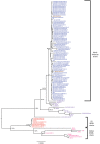Distinct characteristics and complex evolution of PEDV strains, North America, May 2013-February 2014
- PMID: 25279722
- PMCID: PMC4193278
- DOI: 10.3201/eid2010.140491
Distinct characteristics and complex evolution of PEDV strains, North America, May 2013-February 2014
Abstract
Porcine epidemic diarrhea virus (PEDV), which emerged in the United States in 2013, has spread throughout North America. Limited availability of PEDV complete genomes worldwide has impeded our understanding of PEDV introduction into the United States. To determine the relationship between the North American strains and global emerging and historic PEDV strains, we sequenced and analyzed complete genomes of 74 strains from North America; the strains clustered into 2 distinct clades. Compared with the initially reported virulent US PEDV strains, 7 (9.7%) strains from 4 states contained insertions and deletions in the spike gene (S INDELs). These S INDEL strains share 99.8%-100% nt identity with each other and 96.2%-96.7% nt identity with the initial US strains. Furthermore, the S INDEL strains form a distinct cluster within North American clade II, sharing 98.6%-100% nt identity overall. In the United States, the S INDEL and original PEDV strains are co-circulating and could have been introduced simultaneously.
Figures



References
Publication types
MeSH terms
Substances
LinkOut - more resources
Full Text Sources
Other Literature Sources
Research Materials

